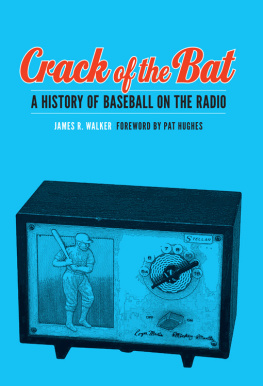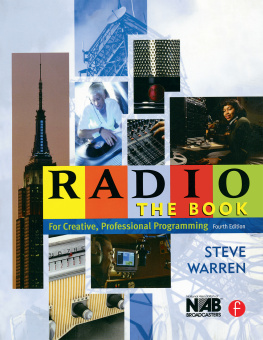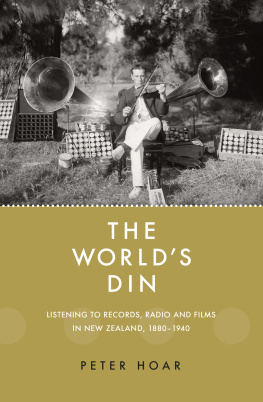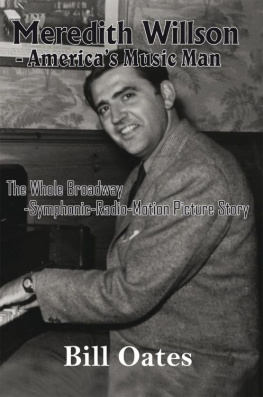
Uploading the First Broadcast Medium
Matthew Lasar

Copyright 2016 by Matthew Lasar
All rights reserved. No part of this publication may be reproduced, stored in a retrieval system, or transmitted, in any form or by any means, electronic, mechanical, photocopying, recording, or otherwise, except for the inclusion of brief quotations in a review, without prior permission in writing from the publisher.
Library of Congress Cataloging-in-Publication Data
Names: Lasar, Matthew, 1954 author.
Title: Radio 2.0 : uploading the first broadcast medium / Matthew Lasar.
Description: Santa Barbara, California : Praeger, 2016. | Includes bibliographical references and index.
Identifiers: LCCN 2015040263 | ISBN 9781440832437 (hardback) | ISBN 9781440832444 (ebook)
Subjects: LCSH: Internet radio broadcasting. | Digital audio broadcasting. | Radio broadcasting. | BISAC: TECHNOLOGY & ENGINEERING / Telecommunications.
Classification: LCC TK6562.D54 .L37 2016 | DDC 384.3dc23
LC record available at http://lccn.loc.gov/2015040263
ISBN: 9781440832437
EISBN: 9781440832444
20 19 18 17 16 1 2 3 4 5
This book is also available on the World Wide Web as an eBook.
Visit www.abc-clio.com for details.
Praeger
An Imprint of ABC-CLIO, LLC
ABC-CLIO, LLC
130 Cremona Drive, P.O. Box 1911
Santa Barbara, California 93116-1911
This book is printed on acid-free paper 
Manufactured in the United States of America
To my friend Bob Mason
Contents
Acknowledgments
First of all, my gratitude goes out to Professor Ralph Engelman of Long Island University for bringing my scholarship to ABC-CLIOs attention, making it possible for me to embark on this project. It has been quite a challenge, but made easier and more pleasant by my correspondence with editor Rebecca Matheson, who has always been there to help me with difficult problems. Many thanks as well to ABC-CLIOs production editor Nicole Azze and Lumina Datamatics project manager Magendra Varman. Friends, colleagues, and correspondents took time from their busy schedules to read drafts of my manuscript, to offer their thoughts, or to answer questions. These include Gary Coates, Deborah Kaufman, Bennett Z. Kobb, Raphael Lasar, Bob Mason, Paul Riismandel, Alan Snitow, and Jennifer Waits. Radio scholars Jack Mitchell and Michael Huntsberger took a look at the thing and pulled me back from various wrong turns or dead ends. Conversations with Rusty Hodge were always fun and helpful. Professor Mark Cioc at the University of California at Santa Cruz, where I teach history courses, got me a grant to attend the 2015 SXSW conference in Austin, Texas, which was tremendously useful to my thinking. My wife, Sharon Wood, scoured the text for conceptual and grammatical glitches and assured me in moments of desperation that I could get this project done. So did my good friend Sherry Gendelman. Finally, I am very grateful to Eric Klein, Paul Riismandel, and Jennifer Waits, my colleagues at the blog Radio Survivor (radiosurvivor.com), for all they have taught me about radio, whatever exactly it is at this point. Their observations and wisdom pop up at various spots in the narrative, but neither they nor anyone else besides me is responsible for what you are about to read.
Introduction
Once upon a time, radio was easy. Before World War II one placed a box in ones living room or kitchen called a receiver, and it connected the listener to a comparatively small number of audio signals on what was and is still called the Amplitude Modulation, or AM, band. The owner of this device read about what programs were available in the local newspaper, be they one of Franklin Roosevelts Fireside Chats, or a drama like Bulldog Drummond, or Benny Goodman on Saturday night, and then tuned in. It was really that simple. This was the way most people listened to radio. They did not listen to it directly through their telephones. Nor could they listen to it through some other gadget. An AM radio receiver was what there was.
Things got a little more complicated by the late 1940s. Now radio signals could be modulated by frequency, hence the sobriquet Frequency Modulation, or FM. This means of transmission sounded better; hence it gradually became a preferred means for broadcasting music. Longer playing records and magnetic tape became available as a means for recording and playing sound. Following World War II hi-fi stereos and tape players became part of the listening landscape; they often integrated radio reception into their suite of console options. Next came portable players, such as Walkmans, Discmans, and boom boxes. By the late 1980s, radio provided a much richer range of offerings.
Then came the Internet. Suddenly the radio world exploded with possibilities: streaming audio, downloadable audio, preference tracking music players like Pandora, on-demand services like Spotify, applications that allowed subscribers to curate music via playlists, online rooms that enabled groups of listeners to text each other while listening and podcasting. A century after the dawn of broadcasting, radio stopped being simple. It became a plethora of gadgets, formats, and services, so many that the question What is radio? no longer had any easy, resolvable answer.
This book is a history of Internet radio, but also of radio in general during what can roughly be called the Internet era, primarily in the United States of America, but also elsewhere. It traces the trajectory of Internet radio from the later years of AM/FM broadcast radio through Internet radios formative decades: the 1990s and 2000s and 2010s. As such, the narrative offers a series of broad, interpretive observations about its subject.
First, the transition to Internet radio has been a journey from one kind of media landscape to a very different sort. The first, AM/FM broadcasting, was characterized by the presentation of sounds to broad mass audiences whose participants often understood themselves as such. The second, Internet broadcasting, often specialized in the individualization, or, to use the vernacular, the personalization of listening, an experience that one Internet radio pioneer has described as asynchronous. Services such as Pandora literally broke down the audience experience into millions of atomized, self-customized channels. No two subscribers heard the same stream. Even online services that attempted to replicate the AM/FM tradition found themselves operating in environments that emphasized niche rather than the public square.
Second, while this trend toward personalization characterizes the period, its growth as a social/technological practice predated Internet radio. One popular explanation for the perceived decline of AM/FM radio in the late twentieth century focuses on the emergence of the Clear Channel approach with its emphasis on centralized, automated programming and the decline of the locally based independent radio station. There is much to be said for the arguments associated with that narrative. But as this devolution took place, the public also embraced what could be described as pre-Internet technologies that allowed for the individualization of listening on a global scale. These included cassette players such as the boom box and the Walkman, the gadgets and social practices that historians associate with turntablism, and that consummate gateway-to-the-Net digital format: the CD.











